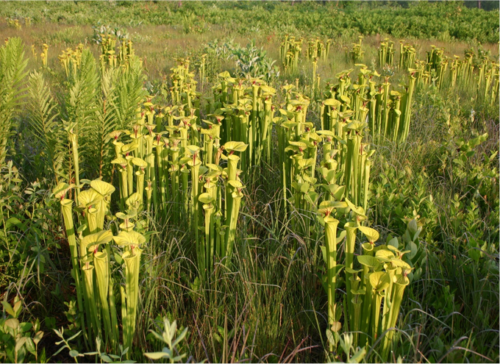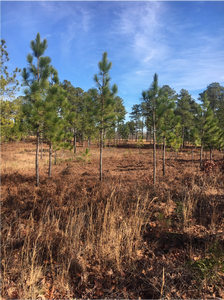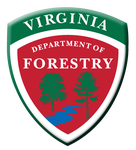Native Ecosystem Restoration Expanded in Southeastern Virginia
February 16, 2021 11:45 am

The Virginia Department of Forestry (VDOF) and the Meadowview Biological Research Station (MBRS) recently acquired land that expands an existing conservation easement on the Joseph Pines Preserve in Sussex County. The 196-acre purchase by MBRS increases the preserve property to nearly 428 acres. The easement, donated to VDOF by MBRS, includes the entire preserve.
“This partnership exemplifies the positive impact of multiple agencies and nonprofit organizations working together with a shared vision,” said Virginia Secretary of Agriculture and Forestry Bettina Ring. “As a result of this conservation project we are seeing the restoration of a rare forest community with public access.”
The property, which is open to visitors for low-impact use, is managed to restore a native longleaf pine ecosystem. Longleaf pine’s native range once extended from southeast Virginia to east Texas. Although no natural longleaf pine forests remain in Sussex County, historical forest models indicate that longleaf would have likely been present on the Joseph Pines Preserve landscape. A joint research initiative with the USDA Forest Service in 2018 confirmed the assumption – an old log pulled from wetlands on the property was tested and identified as longleaf pine.
“Five centuries ago, longleaf pine was arguably the most common tree species in upland southeast Virginia,” said Virginia State Forester Rob Farrell. “VDOF and many of our partners have long recognized the importance of longleaf restoration to environmental and economic health, and we are excited to strengthen our efforts through the expansion of this easement.”
VDOF has held an easement on the preserve’s original 232 acres since 2012. The recent purchase of the additional acreage was made possible by grant funding from the Virginia Land Conservation Fund, the Cameron Foundation, a third anonymous foundation, a loan guarantee from Atlantic Union Bank, and a loan from the Virginia Department of Environmental Quality Clean Water Revolving Loan Fund. MBRS’ goal is to expand the preserve to 2,000 acres in Sussex County, by adding property and amending the easement over time.
“Our mission is to put back parts of the system that were lost, to preserve the history, and restore this land as best we can to what we think it was,” said Dr. Phil Sheridan, Director of MBRS.
With its collective land holdings, MBRS has one of the largest sources of native Virginia longleaf pine seed. MBRS has been a pioneer of longleaf conservation and research and plans to support their conservation efforts by working with VDOF to harvest an existing loblolly pine plantation on the property and convert it to native Virginia longleaf pine. MBRS and VDOF determined that the native longleaf pine genotype is superior for in-state planting because of greater survival, growth, water-use efficiency, and fecundity over other southern seed sources.
“Our organization is a part of the VDOF family. We have a long history of working together with the department, especially on activities to restore longleaf pine. Our work together ultimately culminated with acquiring land to meet our research and preservation goals,” said Dr. Sheridan.
Longleaf Pine Ecosystems

Longleaf pine forests are fire-dependent, meaning fire is required for regeneration by preparing an open and clean seedbed. Longleaf ecosystems host a number of other rare species in Virginia, including red-cockaded woodpeckers and two species of pitcher plants. Intensive harvesting and a legacy of fire suppression in the Southeast caused significant decline of the longleaf forests and other fire-dependent species. Joseph Pines Preserve, for example, was likely fire-suppressed for over 100 years. Preserve managers have reintroduced fire to the landscape and will continue work to restore the native ecosystem through the reintroduction of at least 18 rare plant species and three rare animal species.
Some species found in the disappearing longleaf forests were not preserved in seedbanks and have been lost forever. Among them are two pitcher plant species, making them a primary focus for the MBRS. Joseph Pine Preserve hosts six rescued native populations of yellow pitcher plants, five of which have gone extinct in Virginia. “Preserving this habitat means we’re preventing extinction and conserving biodiversity,” said Dr. Sheridan.
Importance for Forest Conservation
Restoring longleaf pine to the landscape is important for many reasons. In addition to supporting critical habitat, longleaf can be a commercially valuable tree. They contribute to Virginia’s overall forest health because they may be more resistant to pests (like southern pine beetle) than other species of pine, due to inherent characteristics of the tree and the use of fire in longleaf forest management. Longleaf pine forests can also be important sources of fresh water.
Frequent prescribed burning means less thickets and dense foliage, making it easier to walk along the trails. Numerous coveys of native bobwhite quail (another diminished species in Virginia) may startle the unsuspecting hiker. Preserve managers have also heard calls from the rare Bachman’s sparrow on the property. The Preserve also hosts the only known publicly accessible yellow pitcher plant site.
“Identifying forestland with significant conservation value is an essential part of VDOF’s land conservation programs,” said VDOF Forestland Conservation Specialist Amanda Scheps. “The Joseph Pines Preserve is an outstanding example of land that contains important habitat and supports important research to restore a diminished species.”
About MBRS and Joseph Pines Preserve

Meadowview Biological Research Station is a non-profit 501(c)(3) organization dedicated to preserving and restoring rare wetland plants, habitats, and associated ecosystems on the coastal plain of Maryland and Virginia. Land acquisition and management is made possible through the generous support of donors, state, federal, and private foundations, and volunteers. To learn more about how you can help, visit: www.pitcherplant.org
The primary purpose of Joseph Pines Preserve is habitat restoration and conservation. Although the property is open to the public for low-impact permitted activities, visitors must submit an access and use permit prior to entering the property; the preserve is closed during deer hunting season. Examples of permitted activities are hiking and birdwatching, while ATV and horseback riding are prohibited to prevent damage or weed introduction that would negatively impact rare plant species, Plant collection is strictly forbidden.
About the Virginia Department of Forestry

The Virginia Department of Forestry protects and develops healthy, sustainable forest resources for Virginians. With nearly 16 million acres of forestland and more than 108,000 Virginians employed in forestry, forest products and related industries, Virginia forests provide an overall economic output of more than $21 billion annually.
Headquartered in Charlottesville, the Agency has forestry staff members assigned to every county to provide citizen service and public safety protection across the Commonwealth, which it’s been doing now for more than 100 years. VDOF is an equal opportunity provider.
Contacts
Michelle Stoll, Virginia Department of Forestry, (434) 282-4014, michelle.stoll@dof-dev.sitevision.com
Dr. Phil Sheridan, Meadowview Biological Research Station, (804) 633-4336, meadowview@pitcherplant.org
Featured Image: Native yellow pitcher plant at Joseph Pines Preserve, Photo Credit: Meadowview Biological Research Station
Tags: Conservation, Longleaf Pine, Partnerships, Wildlife, Woodland Plants
Category: Forestland Conservation
